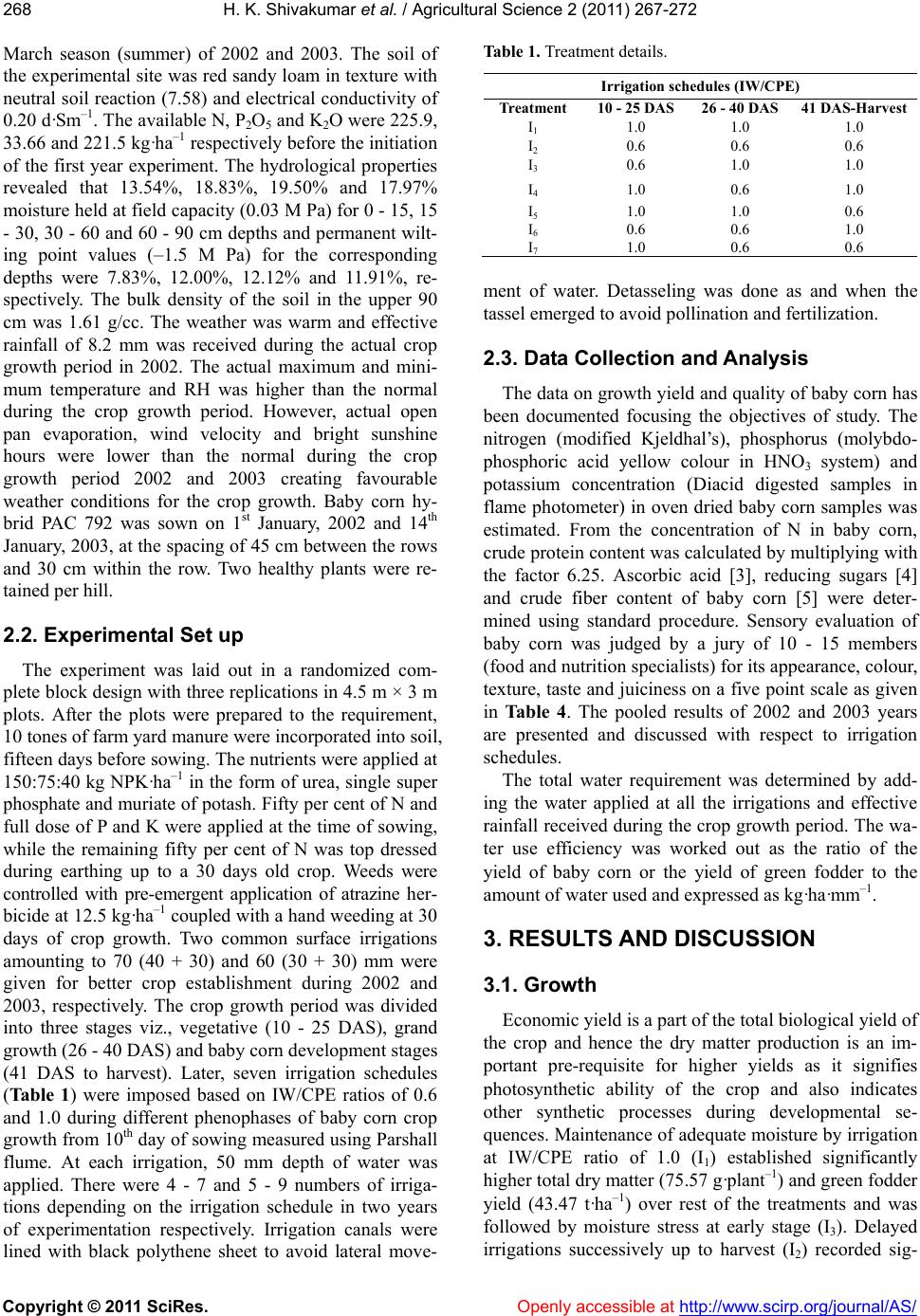
H. K. Shivakumar et al. / Agricultural Science 2 (2011) 267-272
Copyright © 2011 SciRes. Openly accessible at http://www.scirp.org/journal/AS/
268
March season (summer) of 2002 and 2003. The soil of
the experimental site was red sandy loam in textur e with
neutral soil reaction (7.58) and electrical conductivity of
0.20 d·Sm–1. The available N, P2O5 and K2O were 225.9,
33.66 and 221.5 kg·ha–1 respectively before the initiation
of the first year experiment. The hydrological properties
revealed that 13.54%, 18.83%, 19.50% and 17.97%
moisture held at field capacity (0.03 M Pa) for 0 - 15, 15
- 30, 30 - 60 and 60 - 90 cm dep ths and permanent wilt-
ing point values (–1.5 M Pa) for the corresponding
depths were 7.83%, 12.00%, 12.12% and 11.91%, re-
spectively. The bulk density of the soil in the upper 90
cm was 1.61 g/cc. The weather was warm and effective
rainfall of 8.2 mm was received during the actual crop
growth period in 2002. The actual maximum and mini-
mum temperature and RH was higher than the normal
during the crop growth period. However, actual open
pan evaporation, wind velocity and bright sunshine
hours were lower than the normal during the crop
growth period 2002 and 2003 creating favourable
weather conditions for the crop growth. Baby corn hy-
brid PAC 792 was sown on 1st January, 2002 and 14th
January, 20 03, at the spacing of 45 cm between the rows
and 30 cm within the row. Two healthy plants were re-
tained per hill.
2.2. Experimental Set up
The experiment was laid out in a randomized com-
plete block design with three replications in 4.5 m × 3 m
plots. After the plots were prepared to the requirement,
10 tones of farm yard manure were incorporated into soil,
fifteen days before sowing. The nutrients were applied at
150:75:40 kg NPK·ha–1 in the form of urea, single super
phosphate and muriate of potash. Fifty per cent of N and
full dose of P and K were applied at the time of sowing,
while the remaining fifty per cent of N was top dressed
during earthing up to a 30 days old crop. Weeds were
controlled with pre-emergent application of atrazine her-
bicide at 12.5 kg·ha–1 coupled with a hand weeding at 30
days of crop growth. Two common surface irrigations
amounting to 70 (40 + 30) and 60 (30 + 30) mm were
given for better crop establishment during 2002 and
2003, respectively. The crop growth period was divided
into three stages viz., vegetative (10 - 25 DAS), grand
growth (26 - 40 DAS) and baby corn development stages
(41 DAS to harvest). Later, seven irrigation schedules
(Ta b l e 1 ) were imposed based on IW/CPE ratios of 0.6
and 1.0 during different phenophases of baby corn crop
growth from 10th day of sowing measured using Parshall
flume. At each irrigation, 50 mm depth of water was
applied. There were 4 - 7 and 5 - 9 numbers of irriga-
tions depending on the irrigation schedule in two years
of experimentation respectively. Irrigation canals were
lined with black polythene sheet to avoid lateral move-
Table 1. Treatment details.
Irrigation schedules (IW/CPE)
Treatment 10 - 25 DAS26 - 40 DAS 41 DAS-Harvest
I1 1.0 1.0 1.0
I2 0.6 0.6 0.6
I3 0.6 1.0 1.0
I4 1.0 0.6 1.0
I5 1.0 1.0 0.6
I6 0.6 0.6 1.0
I7 1.0 0.6 0.6
ment of water. Detasseling was done as and when the
tassel emerged to avoid pollination and fertilization.
2.3. Data Collection and Analysis
The data on gro wth yield and quality of baby co rn has
been documented focusing the objectives of study. The
nitrogen (modified Kjeldhal’s), phosphorus (molybdo-
phosphoric acid yellow colour in HNO3 system) and
potassium concentration (Diacid digested samples in
flame photometer) in oven dried baby corn samples was
estimated. From the concentration of N in baby corn,
crude protein content was calculated by multiplying with
the factor 6.25. Ascorbic acid [3], reducing sugars [4]
and crude fiber content of baby corn [5] were deter-
mined using standard procedure. Sensory evaluation of
baby corn was judged by a jury of 10 - 15 members
(food and nutrition specialists) for its appearance, colour,
texture, taste and juiciness on a five point scale as given
in Table 4 . The pooled results of 2002 and 2003 years
are presented and discussed with respect to irrigation
schedules.
The total water requirement was determined by add-
ing the water applied at all the irrigations and effective
rainfall received during the crop growth period. The wa-
ter use efficiency was worked out as the ratio of the
yield of baby corn or the yield of green fodder to the
amount o f wat e r used and expressed as kg ·h a·mm–1.
3. RESULTS AND DIS CUSSION
3.1. Growth
Economic yield is a part of the total biological yield of
the crop and hence the dry matter production is an im-
portant pre-requisite for higher yields as it signifies
photosynthetic ability of the crop and also indicates
other synthetic processes during developmental se-
quences. Maintenance of adequate moisture by irrigation
at IW/CPE ratio of 1.0 (I1) established significantly
higher total dry matter (75.57 g·plan t–1) and green fodder
yield (43.47 t·ha–1) over rest of the treatments and was
followed by moisture stress at early stage (I3). Delayed
irrigations successively up to harvest (I2) recorded sig-